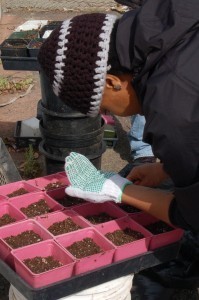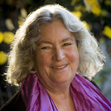Starhawk's Blog, page 3
October 21, 2012
Elections 2012
Here in California, there’s only two more days to register to vote. And if you haven’t, I urge you to do so. Now, I have to say my circles of friends and acquaintances include few if any potential Romney voters. But they do include people who are so disaffected, or feel so frustrated, angry and disempowered by the political system, that even the sheer raw theater of it doesn’t move them to participate. And others who enjoy saying, “Don’t vote, it only encourages them,” which is funny but patently untrue in an election year when the far right is working so hard to discourage people from voting. If they’re going to such lengths to keep people from the polls, there must be something there that we want!
I’m thinking about an exchange I had with a young woman who was in our job training program last year. We’ll call her Shawna. I asked the group if they voted. Shawna said she registered when she turned eighteen, but they sent her the sample ballot, “and I couldn’t figure out all that bullshit. I threw it away.”
“But Shawna,” I said, “Did you know that all over the country, rich white guys are trying every trick in the book to keep young, African-Americans like yourself from voting?”
“They don’t have to try,” she said, “Cuz I ain’t gonna do it!”
Shawna grew up in public housing, on welfare. At eighteen, she’s already spent many months incarcerated in juvenile hall. Her boyfriend was murdered, another victim of gang violence. She’s bright, and likes to read, but her education did not prepare her well for either college or a job—and those months in juvie didn’t help.
I didn’t have much success in persuading Shawna that voting was relevant to her life. Our discussion took place long before this election, and the current crop of propositions wasn’t yet on the ballot. But were I able to talk with her today, here’s some ways that voting on the issues just here in California might make a difference to her life:
Prop 30 would raise money for better public schools.
Defeating Prop 32 would keep the Koch brother and the corporate power-mongers from effectively excluding the unions and the candidates who back the interestes of working people from political power.
Prop 34 would end the death penalty in California! Which inordinately affects people of color.
Prop 36 would reform our horrific ‘three strikes you’re out’—another issue that is of deep concern to communities of color who are targeted for prison. Right now, a person who is charged with even a nonviolent offense or a petty crime can go to jail for life, with no judicial discretion. The reform would make it so that offenses need to be serious, violent ones. And dramatically reduce the chance that Shawna or her friends would spend a lifetime in prison for some stupid shit they do to be cool at nineteen!
Prop 37 would require labeling of genetically modified foods, giving us all an informed choice about what we eat, and ending the free ride Monsanto and the GMO producing companies have gotten to inflict their unwanted, unsafe and damaging products on the unknowing public.
And that’s just the propositions! What about voting for President?
It’s true, neither Obama nor Romney espouses my personal ideals nor champions some of my most important issues. But there are many, many ways in which an Obama victory would make life better for Shawna, and for me.
Shawna doesn’t want to get pregnant, like so many of her girlfriends have done. Obama and the Democrats stand strong for women’s reproductive freedom, for making contraceptives available and part of insured health plans, and for protecting a woman’s right to choose. Romney et al have promised to make abortion illegal—some of them have stated in all circumstances, even rape (because they claim that a woman can’t get pregnant if the rape is ‘legitimate’) or when the woman’s life is in danger (they claim it’s never in danger from pregnancy!?!) The next President will likely appoint two Supreme Court justices, which will have a huge impact on protecting Roe vs. Wade and many other issues for decades to come.
Shawna is thinking of enlisting in the military. For her, that seems like the best option to some sort of future. While Obama is no pacifist, and continues to support a drone program I find immoral and unconscionable, he did get us out of Iraq. He is moving us out of Afghanistan, more slowly than I’d like, but at least he’s moving in the right direction. Romney, on the other hand, objects to any timetable to get out of Afghanistan, and is highly likely to let his warmongering advisers get us into a whole new war with Iran. Jill Stein, the Green Party candidate, is closest to my ideals but has no potential to actually win—and if by some miracle she did, she’d have no party backing in Congress, no experience and no clout.
In the Bayview, when there’s money for summer jobs and training, the murder rate goes down. When the money dries up, the murder rate climbs. Obama’s stimulus resulted in lots of jobs that summer for Shawna and her friends, and fewer deaths. Under Romney, the chances of any money for improving the lives of Mary and her friends are as likely as my becoming a champion girl jockey and winning the Kentucky Derby. Under Obama—especially if we could get the obstructionist Republicans out of the way—we’d see more resources and more hope.
Then there’s health care. Under Romney, Mary’s best hope of getting health insurance would be to go on welfare and qualify for Medicaid, or succumb to the forces driving young people from her ‘hood into prison. As for me, as a self-employed writer closing in on the age where I could soon qualify for Medicare, health insurance remains my single largest expense, more than my house payments, more than food. And that’s after dropping down to a minimal policy. Obamacare is not the single payer system I’d prefer and which would make most moral and fiscal sense. But its hella better than what we’ve got now, especially for someone who is not part of some big corporation that helps pay for my insurance. And should Romney get in and turn Medicare into a private voucher system it would have a devastating affect on my chances of avoiding a destitute old age!
Beyond Obama and Romney, think what a Republican victory would say about us, the people of the United State. If Romney wins, no matter by how small a margin or by how many dirty tricks and miscounted ballots, his folks will claim a mandate for the most extreme, right-wing policies. It would vindicate the right of the 1% to skim the cream and leave the dregs for the rest of us. The lies, the trickery, the influence of immense wealth, the voter-suppression tactics, the intimidation, the cheating and the overt and covert racism will all be rewarded.
And don’t try to tell me that under a Romney presidency, things will get so bad that people will finally rise up and make a revolution. I’ve been hearing that since Nixon ran against Humphrey in 1968, and you know what—it’s never happened, yet. Never even gotten close. Under a really bad, right-wing President things get worse, and people get more discouraged, more downtrodden, more hopeless and more apathetic. Organizing and motivating people to take action gets harder, not easier!
If Obama wins, it will show that the American people want something else—a place where the playing field is leveled, where everybody gets a fair chance. That doesn’t mean I’m under the illusion that Obama will give it to us. He’ll do what’s doable—and it will be up to us to make it not only doable but inescapable. Not in the voting booth, but in all the places where we organize and agitate and protest and build alternatives. That’s never easy—but under Obama the conditions for organizing will be far better than under Romney, if only because hope disappointed is more galvanizing than despair confirmed.
Elections are not the arena where I express my ideals—I do that in the garden, and in my writing, and in the streets. Elections are where I get pragmatic, because they do matter, and the differences between the candidates can mean life or death to folks like Shawna and to me.
So if you’re not voting out of principle, or you’re in a swing state refusing to vote for Obama because of his real failures to live up to the values he originally espoused, I’d ask you just to stop for a moment and think about Shawna. Think about me–and not just the impact on my mental health of having to watch that snide, lying, con artist for the next four years! Include in your ideals the real-life impact a Republican victory would have on a young black woman from the inner city, on an aging writer, on hundreds and thousands of other folks here and around the world for whom the nuances of difference might mean life or death.
Then vote your conscience. But for Goddess sake, get off your high horse and your butts and get out there and vote!
Here’s a couple of links to people who have said this all far more eloquently than me:
Daniel Ellsberg. “Defeat Romney, Without Illusions About Obama.”
Stephen Zunes. “My Support for Ralph Nader: Ten Years Later: Lessons Learned.”
https://www.commondreams.org/view/2010/11/01
Rebecca Solnit. “The Rain on Our Parade: A Letter to my Dismal Allies.”
http://www.tomdispatch.com/blog/175598/tomgram%3A_rebecca_solnit,_we_could_be_heroes/
KQED Guide to the California Propositions:
http://www.kqed.org/news/politics/election2012/statepropositions-guide.jsp
July 1, 2012
A Pagan Response to the Affordable Care Act
Jason Pitzi-Waters, of the Pagan Newswire Collective, asked a few of us to respond to the Supreme Court’s decision that the Affordable Care Act is constitutional. Here’s mine:
A Pagan response—or rather, this Pagan’s response for there no universal agreement among Pagans on any issue–to the upholding of the Affordable Care Act has two aspects: is it good for us, individually and as a community, and is it in concert with our Pagan values.
While the Act is not as good for me, individually or many of us as a single-payer system would be, it is definitely an improvement over the callous and greed-ridden system we’ve got. Like many other Pagan writers and teachers, I’m self-employed and have been pretty much all my adult life. I’ve had health insurance since my mother brow-beat me into getting it in my twenties, with the same company. While I’m pretty healthy for my age, I’ve seen my premiums go up and up every year, to the point that they were costing me more than my mortgage, more than my food budget, more than anything else. Now, if I were being taxed for a single-payer system, when my income went down my payments would go down. But with private insurance, the price just keeps going up and up and up! When it finally reached over $1200 a month, I started looking for other options. I tried switching companies, but I’m now over sixty, overweight (not alone among Pagans in being so!) and with minor but irritating health problems that somehow drove my projected premiums up even higher! So I switched to a lower-cost plan that has a $6000 deductible. That would keep me from losing my house should I get a serious illness, and having lost five friends in the last five months, mostly to cancer, I can’t ignore that possibility. I’m still trying to save up the $6000 to have ready in the bank should I need it suddenly—because if I do get sick, I won’t be able to travel and teach which provides the bulk of my income.
Meanwhile, I encountered the dreaded Socialized Medicine when I was in England and needed a new asthma inhaler. I was able to get an appointment at the local clinic in Totnes—the same day I asked for one. I saw a doctor, who gave me a new prescription. He very apologetically informed me that I would have to pay for it, he was so sorry, because I’m not on National Health. I said that was okay, as an American, I was used to it. The clinic had a pharmacy on the premises, and the pharmacist filled the prescription, also expressing regret and embarrassment that I had to paid. He then charged me just over 5 English pounds—less than $10, for two inhalers, each of which costs me about $35 in the US!
I left, infuriated—not at the National Health, but at our own rip-off system. Why should we pay two, four, seven times as much if not to enrich somebody at our expense? Since I shifted my insurance, and since my own trusted doctor retired, I haven’t been to see a doctor since, except for a couple of weeks ago when I had a serious bout with asthma after camping out in the desert. I went to the clinic at the University of California. I had to fill out a form before I saw anyone, stating my financial qualifications to be seen. The form informed me that the visit would like cost something in the neighborhood of $450 dollars! But they couldn’t tell me how much, ahead of time. No one tells you what any specific treatment costs, before you have it—yet you are expected to pay. I know there are many preventive things I should be doing, at my age—like keeping a watch on my blood sugar levels, but when money is short, as it often is, I hesitate to make an appointment or sign up for tests that might break the budget. And I think many others, Pagans and not-Pagans, are in the same situation.
So for me personally, the ACA will help. The insurance exchanges may allow me to get a better policy at lower cost. Some of the provisions of the act assure more justice and fairness for everyone. And while it’s not the National Health or Canada’s public insurance, I believe we are in a better position to push for more when we build on success than we would be if we had to recover from failure.
I didn’t mean to write quite this much. Do I have feelings about this? Evidently I do!
Now, as for the ethics. Our traditions tell us that we Witches were the village healers, the wise women and cunning men who offered herbs and treatment and magic to the sick, especially to the poor. As such we have a special interest in assuring access to health care for all.
I believe the core value in Pagan ethics is the understanding that we are interconnected and interdependent. On that basis, health care is an important right and everyone should have access to it. My personal health is not separate from your well-being. Health is partly a matter of personal responsibility, but all of us are subject to forces beyond our control. If we suffer illness or injury or sheer bad luck, we shouldn’t be left alone to suffer the consequences unaided. We live in a more and more toxic environment, and the constant assaults on our health from pollutants and radiation and the degradation of our food supply are our collective responsibility. No one should be left alone to bear the consequences of our collective failure to protect the life-support systems around us. Rather, it is to all of our benefit to share a public responsibility for our mutual well being, because every single one of us, at some point in life, will need that help. No one gets through life unscathed, and in the end we die. If we truly accept death as part of life, with its attendant break-downs of the body and the many sorts of mischance that befall us along the way, then we do well to offer one another solidarity and succor.
To sum up, universal access to health care is consonant with our core Pagan values of interconnection and interdependence. The Affordable Care Act is a small step toward that end, flawed but better than no change at all. As Michael Moore has said, it should spur us to keep working for a better, more equitable system. But I believe we’ll do better building on a small success than we would have trying to recover from an abject failure. I hope as Pagans we can help to lead the way.
June 5, 2012
Venus Transit and Recall Elections
A beautiful, wild and windy day here in the Cazadero Hills—the day of the Venus Transit when Venus passes directly in front of the sun, a sort of Venusian solar eclipse. It’s an alignment that happened eight years ago—and not again for another century or more. Coupled with a lunar eclipse last night. I’m not much of an astrologer, but those who are say this is a potent moment for calling in the energies of harmony, nurturing and love, the return of the Goddess.
Goddess knows, we need those energies! For today is the day of many state primaries, and the kickoff of the summer election season.
Whatever your politics, whether you vote or don’t vote, whether you register Democrat or Republican, Green or Libertarian, you are about to be subjected to a barrage of negativity that will go on for months and months, fueled by the deep pockets of billionaires who are now free to spend as much as they want to buy elections. The Republicans alone have a war chest of a billion dollars! Think how many mortgages in trouble that money could save, or how many students could get a free college education! Instead, it will be spent to blanket the country with a miasma of negativity, and the Democrats will be scrambling to do their own counterattacks. Energetically, we can prepare to live under a kind of gray miasma, a kind of psychic smog. Yuck!
There are some things we can do about this in the practical realms—ranging from contributing money to good causes to getting out in the streets and staying there, as the students and workers in Quebec have been doing for weeks. A good, loud casserole—that means banging pots and pans each night as a political protest—might help drive away some evil spirits.
But I want to talk about what we can do energetically. If you are an ultra-rational sort who doesn’t believe in the woo-woo stuff, here’s where you can stop reading and go do something productive with your day. But I will say this—whether or not you believe this can influence the larger world, this kind of magic will help shift your own energy. If you find yourself spinning off into cycles of fear—anquish—despair—fear, this will help! And if you have more positive energies of your own available, you will be more effective at all the practical things you do.
So if you’re with me, let’s work on shifting the energy around all this. Why should we quietly lie down and suffer under the toxic thought-blanket the political fabricators are laying over us? What would happen if a whole lot of us used our intention and focused imaginations to shift the energies? And why not use some of the energy of this Venus transit—energies which will continue to flood in over the next weeks.
So here’s the idea—a simple meditation you can do alone or in groups, when you have a spare moment or when you find yourself spinning off into those vortexes of impotent rage, stop and do this:
Visualize drains for all the negativity, the fear-mongering and the lies. Like little spinning whirlwinds, spinning counterclockwise, dust devils sweeping up the miasma of the psychic smog, spindles gathering the toxic wool and spinning it down back to earth, down to the fiery magma below us to transform back into pure energy.
Then visualize a clockwise spiral, a rising vortex of compassion, love and hope. You could imagine spinning it around some symbol of justice and freedom—personally, I find the Statue of Liberty to be a potent Goddess symbol.
Release that energy, and ground. Touch the ground, absorb some good, healing energies from the earth, and draw in what you need for your own work and well-being.
Today, June 5, I and Selena Fox of Circle Sanctuary invite our allies to focus on Wisconsin, using the Goddess atop the State Capitol as a beacon to rouse the forces of truth and justice. For today is vote on the recall of Scott Walker, the union-busting governor who was the focus of protests and a sit-in in the Capitol in January of 2011, at the same time as the Arab Spring. Republicans are spending millions to defend him. Democrats—not so much. But this election isn’t just about Democrats and Republicans, it’s a test of whether or not massive amounts of money can determine who gets into office or who stays. Generally the answer to that is ‘yes’—whoever spends the most wins the race. Money is one form of energy, and most of us don’t have a lot of it. But we have other forms of energy—let’s see what we can do!
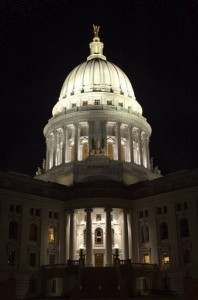
Wisconsin State Capitol buidling with the Goddess on top!
April 19, 2012
Requiem for Isis
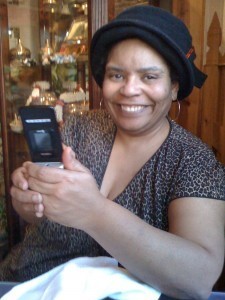 It seems a strange way to honor my friend Isis—cleaning the house, because she was arguably a worse housekeeper even than I am, if such a thing is possible. But that’s the thing about death, especially when it comes suddenly and unexpectedly. It’s not just the sorrow and the grief, but that it seems to suddenly remove the ground from beneath your feet, leaving you hanging in a kind of vertigo, like those cartoons where the characters run off a cliff and hang in the air, legs pumping, for a long, long minute before they fall. You need something to ground you, something simple and achievable, like doing the dishes and sweeping the floor.
It seems a strange way to honor my friend Isis—cleaning the house, because she was arguably a worse housekeeper even than I am, if such a thing is possible. But that’s the thing about death, especially when it comes suddenly and unexpectedly. It’s not just the sorrow and the grief, but that it seems to suddenly remove the ground from beneath your feet, leaving you hanging in a kind of vertigo, like those cartoons where the characters run off a cliff and hang in the air, legs pumping, for a long, long minute before they fall. You need something to ground you, something simple and achievable, like doing the dishes and sweeping the floor.
Isis was my friend since we were both in high school, when she was Becky and I was Mimi. For some reason, when I think of her in those days I always see her in a tree, hanging out in the branches on the grounds of our high school. We were fifteen. I had a pack of Tarot cards and a book I’d gotten at henna-haired Mrs. Larsen’s Bookstore down on Hollywood Boulevard. Isis had a pack of cards, too. No one ever taught us to read them—we just did, and then we got ourselves a booth at the Renaissance Faire. It was a camping tent, really, hung with some filmy cloth, and I made myself a princess dress with a high waist out of iridescent gauze, and we told fortunes for days, and hung out with Witches and beadmakers and potters. Isis was smart and funny and cynical and fearless, a round, bossy girl with milk chocolate skin and a huge smile—a smile that always made you think she knew some
Isis went off to college at Antioch and I somehow ended up stuck in LA, going to UCLA and living in a frat house turned commune, in one big room with nine people. My boyfriend and I shared the closet together. Isis came to visit once; I could tell she didn’t approve of my lifestyle, which really had little about it to approve of. We didn’t talk for a long time, but finally reconnected, I think, at our High School 10th class reunion. By then I had cleaned up my act, ditched the drugs and the boyfriend and actually had a book scheduled to be published. I had also become Starhawk, and she had become Isis. We’d each found our way to the Goddess, on separate paths, but we became friends again. I remember walks in the park when her daughter Morgan was a baby, with our big dog Arnold washing Morgan’s face with his tongue as she sat in her stroller. The baby didn’t seem to mind, and neither did Isis. Isis came to Witch camp–the first we ever did. Morgan was around four, then, and we went climbing on the rocks to look at the tide pools. “Hold my hand, and you won’t fall,” Morgan told me.
Isis own mother died that summer, and she got the news at camp. I remember her heartfelt grief, I see her crying with a wail that was like the essence of mourning. And then she found solace with a hot naturopath, making the tent shake as she reconnected to the life force. Isis didn’t hold back—neither her grief nor her love of life.
One thing I loved about Isis is that she never hesitated to tell me the truth. She was one of the few people I let read my novels in draft, and I knew I could count on her to let me know if I went off track. Johanna, in Walking to Mercury, is not Isis—that is, the facts of her relationship to Maya are not the facts of our lives. But something of the emotional truth is there. Once Isis had a draft of the book in her car, and her lover read it and got furious at her.
“You never told me that you and Starhawk were lovers!”
“We weren’t!”
“Don’t lie! This is you! You can’t tell me it isn’t you!”
I took that as a compliment. We weren’t lovers, in the physical sense, but Isis is one of the people I dearly love. I learned so much from her. I learned to walk down the street and look people in the eye and smile and say, “How ‘ya doin?” I learned how someone could face years of illness and pain with optimism and grace, and still take so much pleasure in life, even as her life grew more restricted. She’s one of the people in my life who made me who I am.
I’m looking at one of her last Facebook Posts:
“I found out today that I’m happy. No matter what happens, under it all, I’m just happy. How great is that?!!!!”
Be happy, Isis, even as we are sad, so sad that you are no longer here to laugh with and scold us and give us that look. Go shed that body of pain, and get ready for the next adventure.
Weaver, weaver, weave her thread
Whole and strong into your web.
Healer, healer heal her pain,
In love may she return again.
March 15, 2012
Emerald City–Some Milestones
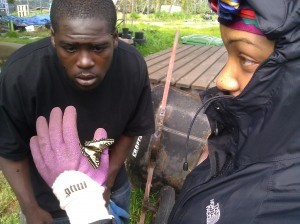
This is why we need gardens in the inner city!
Our Emerald City Green Entrepreneurs Training is going strong—here's some highlights of our first three weeks.
We started by asking, "What are the problems in your community? Who would you have to be to solve them? What kind if superheroes would we need, and who are our role models?" General agreement—grandmothers are the s/heroes!
We learned to make soil mix and started a hundred collards for community gardens. This crew are hard workers, and they take pride in what they do!
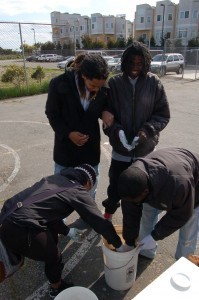
Making soil mix and starting seeds.
We learned to take stem cuttings and do root divisions, and started fifty perennials and fifty comfrey plants!
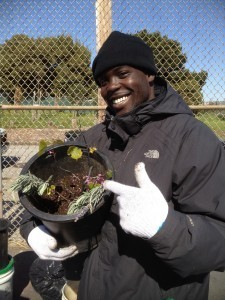
Jaquez really liked the lavender and redbud!
The nutrition aspect—that's still a challenge. But on one memorable day, even the guys actually ate some salad!

Diced chicken and ranch dressing does the trick!
And we've had some very sweet moments—like finding the first butterfly of the spring!
What's working? Engaging young people in the issues that truly affect their lives, and crediting them with the intelligence and the potential power to address them.
What still needs work? Changing habits and life styles is a long process. They can read the label with all the chemicals in the soda, but will still choose it over the apple juice. But at least they'll give the juice a try—especially if we blend it up in a smoothie!
Each day, we begin by setting our goals for the day, and end by reviewing them. Our goals for this program are to expand, as we learn more and more about what works. For that, we need your help. We're hoping to raise another $5000 in the next month, to continue this program. And we would like to raise $20,000 to expand it and double the hours and students over the summer.
If you can help, with a tax-deductible contribution in any amount, we would be so grateful! Donate online at our Earth Activist Training website, and may you, too, find your butterfly!
February 29, 2012
Emerald City–Starting a Green Entrepreneurs Program in Bayview Hunters Point
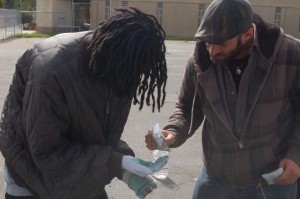
Planting the seeds of a new program.
I'm always a bit nervous, starting a new program, but I realize as I wake early in the morning that my anxiety meter is reading Extremely High today. We are finally starting our new Emerald City Green Entrepreneurs Program—a collaboration between Earth Activist Training, our program that combines permaculture, spirit and activism, and Hunters Point Family, which runs programs for youth and young adults in Bayview Hunters Point, the San Francisco neighborhood with the highest rates of poverty, crime and violence. EAT and HPF have a long-standing relationship, for the last six years EAT has offered support and training for the three urban farms that Hunters Point Family runs. Last year, I taught a permaculture design course for young adults—and a couple of elders—who live in public housing. We'd hoped to continue and expand it over the summer, but ran short of funding.
But now we've begun again. I spent a long time reflecting on what I learned from the last program. At the beginning, it was hard for me to make the shift from teaching permaculture courses to the highly motivated, eager students we generally get to teaching young people who are traumatized, often shut down and fearful of new experiences, and without the kind of background of knowledge or education we generally take for granted. How do you explain a food forest to a bunch of urban youth who have never been in a forest? "Nature builds soil in three places," I remember one session well. "In lake bottoms, in forests, and in prairies."
"What's a prairie?" one student asked.
"Is that like Little House on the Prairie?" another suggested.
By the end, I felt like I was beginning to find my way. I brought in an old friend and former housemate, Senegalese artist Charles Dabo, and asked him to tell the group about his experiences growing up in a village where the young people were taken through rites of passage. The elders would take them out of the village, for weeks or months at a time, in their age-groups, and teach them what they needed to know to move from one stage of life to another. We don't do that much in Western society, and so young people find their own rites, often involving drugs, guns and danger, too often ending in prison or death.

Problems in the community
This time, I wanted to start not with the plants but the people, and to structure the program as a rite of passage. If we take the time to build the inner attitudes and understandings and to make the work and material relevant to the real-life issues these young people face, I thought, they will be far more excited and motivated. So we've structured the program as a Rite of Passage—and this time, I decided to bring in Charles at the beginning. I also recruited Jay Rosenberg, who started the amazing Hayes Valley Farm, an urban farm on a disused freeway offramp in San Francisco. Jay is now working with The Fifth Sacred Thing film production as coordinator of our Green Projects. The movie production is loaning his services and providing us with a bit of seed money to get started. In the long run, when (not if!) the production gets financed, we hope to be able to hire some of our trainees and produce some of the thousands of plants we'll need to create legacy gardens, as our Green Plan envisions. If I look at what's been pushing me to start this project now, it's in part my belief that if we want these things to happen, we'll have a much more compelling argument for investors and finance people if we can say "Look what's already happening" than if we're saying, "Here's all our really good ideas and intentions!"
Another longtime, dear friend of mine, writer, storyteller and Priestess of Oshun Luisah Teish was coming to do some story-telling for Hunters Point Family's Black History Month celebration, so we brought her over to help us inaugurate the program. I was not lacking in backup! Nonetheless, I was not at all sure whether my plan would actually work. Would these streetwise young people go for it, or would they see it as far too woo-woo and irrelevant?
Monday, our first day, was a bit chaotic in starting. Of our six trainees, we ended up with just three—three young women ranging in age from eighteen to twenty-one. That turned out to be a blessing in disguise, because without the guys there, they were able to open up and speak more freely. Charles talked about the Rites of Passage, and they listened intently. We asked them what they like doing most. One writes poetry, another wants to write a book. Oooh, that made me happy! Another loves to do construction, would like to build homes for people. Already in their young lives they've dealt with death and loss. A boyfriend who was killed—a disabled brother. When we ask them who their heroes are, they all say their grandmothers are their heroes. Why? Because they've seen it all. They have the experience, the love and compassion, the wisdom.
"Do you have all that?" one of them asks me. I consider the list. "I do," I say. "But I have enough wisdom to know that you always have to keep learning."
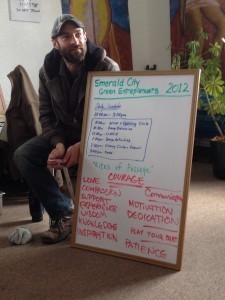
Qualities of a hero.
When Teish comes in the afternoon, she politely suggests that Jay take off and we all settle in for some serious girl talk. For two hours, she regales us with stories of her life growing up in East LA, being part of a gang but deciding instead to take another path that led to her being a dancer, a writer, and a spiritual teacher. She gives the young women some very blunt advice—and tells stories that make us laugh. Her folks talked in proverbs, she says. Her mother would stalk over, stare down at her with a fixed eye and then finally come out with some piece of wisdom. "Child, don't be like the bulldog in the haystack!"
We laugh at Teish's bewildered expression. "Now what does that mean? My mother is ninety-two years old, and if I were to ask her today, you know what she'd say. "Child, you still haven't figured that out? Keep working on it!'"
On the second day, one of the women has a class, the other two are late coming in. We know that one of the big pieces of learning will just be showing up, and showing up on time. If we can get that covered in the first month or two, we'll be doing well.
But the three young men are there. And Jay and I are able to catch them up. Although we don't have Charles or Teish, the guys open up when we ask them what they see as the biggest problems in their community. Violence and poverty head the list. One of the guys names his mother as his hero, the other two don't have any heroes. But they do have a similar list of qualities—compassion and love start it off. We talk about food, about access to good quality food and health and food justice. The discussion is deep—nonetheless we fail to convince them to eat any salad for lunch. That will be another long process! The girls, more weight-conscious, ate up the salad although one of them made an emergency call to her mother to bring her some Ruffles. Tortilla chips and even sandwich fixings weren't to her liking.
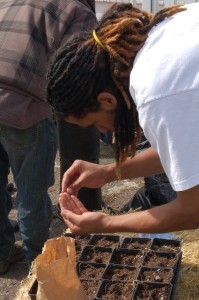
Planting collards.
In the afternoon, we have our first real hands-on project, starting seeds and making soil mix. And they all dive into the work—once we hand out gloves! Actually putting your hands into the dirt will be another long-term learning process. I find it enormously sweet to watch these big, burly guys so seriously and delicately planting the tiny seeds of collards.
We had set a goal of planting one flat apiece—and we surpass it. We teach them how to make the soil mix and they are enthusiastic about doing it and doing it right, making sure it has enough of each of the ingredients. We finish the day with some permaculture pictures. All in all—a great beginning.
We've started the program on faith, with just enough funding for five trainees for two months. We've ended up with five and a half trainees, as one of the young women will miss one day each week because she's in college studying to be a medical assistant. But we like her so much we can't bare to tell her, "No, you can't come." We are really hoping we can get more funding, to increase the number of trainees and the number of hours per week so that some of them can treat this more as a sustaining job rather than a supplement.
We'd love to have your help and support. We hope to raise another $5000 to carry us through April and into May. If you have any spare cash to contribute, your tax-deductible donation will help us change lives and train the next generation of community leaders. Donate Here!
Thanks to all of you whose generous support has sustained our work for so many years!
December 28, 2011
Travels and Occupies
Reflections on my Travels
So, for much of December, I was travelling too far, too fast to blog. Way back last year when I was finishing up the writing of The Empowerment Manual: A Guide for Collaborative Groups, I had some email discussions with the publishers about how to promote it once it came out. New Society is a small, political publisher, and while they are great to work with, use recycled paper, and support all the right causes, they don't have money to spend on book tours. "No problem," I said. "I'll just schedule a few workshops in some key places—like New York, LA, etc. and that'll cover the cost of getting there. Plus I'd rather give a talk or a workshop than sit behind a table at a bookstore desperately hoping someone will come buy the book and have me sign it before I spend far more money than I'm making on all the other books around me in the store."
So, I had quite a schedule already planned for the Fall, and then half the world decided to go Occupy Everything. What could be more perfect timing, given that I'd just written a book on horizontal organizing and collaborative process? Many of my far-flung friends were involved in their local Occupy's, and soon they were emailing me begging me to come. People who found out I'd be in their cities were asking for trainings, and since I'm now hooked into national networks of trainers, I ended up going to Vancouver, Minneapolis, Boston, New York, then home for a day—just long enough to do a forum on nonviolence/diversity of tactics for Occupy Oakland—and then LA, plus a Winter Solstice ritual in Sebastopol. Even for me, this was rather a hectic pace, but it was hella fun and it gave me a quick overview of the movement, like a series of snapshots.
This last month has been a challenging time for the Occupy movement. The forces of repression have struck hard, and most or all of the major Occupations have been forced out. At the same time, winter and cold weather make outdoor activities a challenge. I'll never forget the stalwart folks of Occupy Minneapolis, valiantly maintaining a presence in 10 degree weather! My favorite souvenir of the trip—my Occupy MN hat, made of bushy fake fur! Other memories–Occupy Boston the night eviction was threatened. An action at Goldman Sachs with Occupy Wall Street–followed by an impromptu spiral dance at the Winter Garden across the street. A healing ritual at Zucotti Park. Trainings, trainings, trainings–including one heart-filled workshop my last morning in New York for Occupiers now housed in a church on the West Side. Here's some pics:
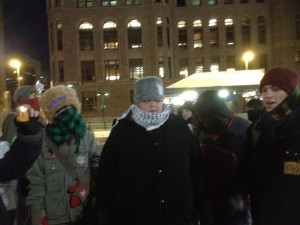
Occupy Minneapolis--seriously cold!
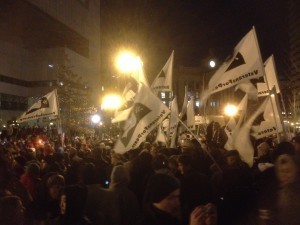
Occupy Boston resists eviction!
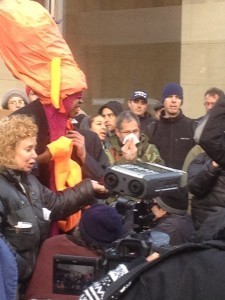
Confronting the giant squid of Goldman Sachs with Occupy Wall Street
But even more than troubles with the cops and city authorities, the biggest challenges the Occupy movement faces seem to be internal. How do we make decisions together? How do we resolve our own conflicts within our groups? Once we've said "We are the 99%", how do we set standards of behavior and say what is okay and what is not? Once we've renounced force and coercion, how do we enforce those standards when we do set them?
None of these are easy questions to answer. While many of them are addressed in my book—and thank you, Starhawk! For buckling down last spring, meeting your deadlines and getting it finished on time, otherwise you'd be kicking yourself in the butt right now, and you're no longer limber enough to do so!—the Occupy movement poses them in a form more stark than I've ever encountered before, in four decades of horizontal organizing. Sitting down in the public square to Occupy and protest an unjust system attracted the very people most impacted by the injustice, some of whom are badly wounded in ways that make it very hard to organize and live together. When your own needs are overwhelming, and unfulfilled, its hard to see that other people might also have needs. When you've had no voice, and somebody offers you a platform to speak and an audience, it can be hard to step back after your allotted two minutes and let others speak. When you've dulled your pain for years with drink or drugs, you can't easily go cold turkey and stop using. And yet when you're trying to create a new society in which everyone has a voice and power is shared, you need everyone to be willing and able to share both power and responsibility.
Consensus is a challenging process at best—when most people are untrained, and even the facilitators don't really understand how the process is supposed to work, and when the participants aren't even in the same consensus reality, Consensus is also a linear thinking process, designed for synthesizing issues into proposals and then making decisions. It's a tool, not a group structure nor a way of life. It requires someone with a linear thinking mind to facilitate, who can keep a kind of outline in their head of topics, subtopics, points A B C and D." When people come to it with the pent-up anger of years of disempowerment, it can simply compound frustration. When the voices in your head compel you to tell the world about the impending arrival of the Space Brothers with the Mysterious Blue Geodes and you theory about how it all relates to the Mayan Calendar, being told you're off topic just doesn't cut it.
Consensus is one tool—and used well it can be a powerful and empowering tool. But it's not the only tool or process we need. There are other ways of coming together that open the heart or encourage participation in different ways. Some of them are discussed in the free download on my website: "The Five-Fold Path of Productive Meetings". And I hope to do more writing and thinking about this in the days to come.

At Zucotti Park in my Occupy MN hat with Priya Warcry.
And now—got to go pack the truck and head up to the ranch to prepare for our upcoming Earth Activist Training! Happy holidays, and a blessed New Year to you all!
December 1, 2011
My New Book: The Empowerment Manual!
My new book, The Empowerment Manual: A Guide for Collaborative Groups is out in the bookstores now, as well as online, and I'm very excited to be able to share it with you all! Click on the link above to get a peek inside and to download the free supplementary chapter: The Five-Fold Path of Productive Meetings. I'm off on a whirlwind tour, doing workshops and trainings on the book and support for various Occupy movements–see the whole schedule here.
When I began writing The Empowerment Manual: A Guide for Collaborative Groups, I wanted to offer some of the benefit of my experience, including my many mistakes, to groups who were organizing without a top-down, hierarchical structure. I've been living and working in such groups for more than forty years, and I felt like the many dreadful meetings I've endured, the in-fights and the painful conflicts, as well as the glorious moments of collective creativity and spiritual ecstasy, should all count for something. I saw so many groups struggling with the same issues, whether they were spiritual circles, working groups, communities struggling to organize or activists planning a protest. And I had a few insights that I felt might be helpful.
I didn't know that half the world would decide, right when the book is coming out, to go sit in the public square and organize leaderless Occupations governed by consensus-based General Assemblies. The Occupy movement springs from many of the same sources that inspired the book—the horizontally organized global justice movement of the last decades and its antecedents, the anti-nuclear and anti-intervention movements of the 'seventies and 'eighties. But now more people than ever before are suddenly immersed in the joys and challenges of organizing non-hierarchically.
Groups without formal hierarchy are potentially empowering on a mass scale. Unfortunately, we come into them from a lifetime of exposure to hierarchy, with its patterns internalized. We have few models and fewer guidebooks to help us learn how to do it a different way. There are thousands of books on how to be a manager or a CEO of a corporation, virtually none about how to walk the delicate line of stepping up to a leadership role in a leaderless group.
Collaborative groups are a different species from hierarchical groups, and understanding those differences can help us make them work more effectively. As kids, when we get in a fight Mom or Dad can step in and say, "You two, break it up!" In a top-down group, the boss or leader steps in for Dad. But when we remove that authority, there's no one to say, "Okay, time out. Now apologize to each other, kiss and make up." Conflicts can be harder to resolve, unless we realize that the group itself must find clear agreements on how to handle conflict and how to support one another in directly and creatively solving our disputes.
Communication is more complex in a collaborative group. In a hierarchy, there's a chain of command. You know whom to report to, and who reports to you. But in a collective, ten of us might make a decision—forgetting that member number eleven is home sick with stomach flu. Maybe we also forget to inform Number Eleven of our decision—and then forget that we've forgotten. Number Eleven discovers we've set a key policy without her, and feels hurt and slighted. It's clear to her that we've deliberately left her out of the loop, as we always do! Painful meetings and hours of mediation could all be avoided if we'd simply thought to ask, at the end of our meeting, "Who else needs to be informed of this and who is going to tell them?"
The Occupy movement faces some of the greatest challenges I've ever encountered around group dynamics and group process—it's so huge,grew up so fast and so spontaneously and found itself smack in the middle of some of society's worst unsolved problems. Former student body presidents are encamped in the midst of raving drunks, trying to come to consensus in large groups. It's fascinating, often exasperating, and that's why I'm spending as much time as I can offering trainings.
I also offer the book as a resource. I recommend it because it contains insights and a framework that can help groups function, whether they are unwieldy Occupations or tight circles of friends engaged in a project. I know this because it has helped me—although presumably I already knew what's in it. But reading, researching and pulling the lessons together into a coherent form has helped me become a better group member and a more effective mediator.
If you're working in any sort of collaborative group, you'll find valuable insights in The Empowerment Manual. I say this not just to get you to buy the book—although of course I want you to buy it, that will help a very wonderful small, political publisher stay in business and will buy me some time to write a sequel to The Fifth Sacred Thing, my next project. But far more than that, I'm hoping you'll read the book, work with it, use it, improve on it, and find your own groups working more effectively, and our common work to build a better world will thrive.
"To choose a positive future, we need the imagination, the commitment and passion that can never be commanded but can only be unleashed in groups of equals. Those groups need to work and function well. That's why I've written this book."
The book is out in bookstores now, and available online through my website, New Society, and of course, on Amazon and elsewhere. Check out the New Society blog about it here.
Some of my older books have also become newly relevant with the rise of the Occupy movement, especially for anyone interested in its antecedents. In particular, Dreaming the Dark: Magic, Sex and Politics and Truth or Dare: Encounters with Power, Authority and Mystery look at the internal wounds we carry from millennia of war, hierarchy and patriarchy, and reflect some of the horizontal organizing in the antinuclear and anti-itntervention movements of the 'seventies and 'eighties. Webs of Power: Notes from the Global Uprising tracks the global justice movement from the Seattle blockade of the WTO in 1999 through September 11, and contains nuanced discussions of nonviolence, diversity, and spirit. Find them all here!
I doubt I'll have time to blog in the next few weeks, but I'm sure I'll have lots to ponder from my travels. Hope to see some of you on the road!
November 9, 2011
An Open Letter to the Occupy Movement: Why We Need Agreements
Alliance of Community Trainers is the training collective I work with. Here's our statement to the Occupy movement on questions of violence, nonviolence and strategy:
From the Alliance of Community Trainers, ACT
The Occupy movement has had enormous successes in the short time since September when activists took over a square near Wall Street. It has attracted hundreds of thousands of active participants, spawned occupations in cities and towns all over North America, changed the national dialogue and garnered enormous public support. It's even, on occasion, gotten good press!
Now we are wrestling with the question that arises again and again in movements for social justice—how to struggle. Do we embrace nonviolence, or a 'diversity of tactics?' If we are a nonviolent movement, how do we define nonviolence? Is breaking a window violent?
We write as a trainers' collective with decades of experience, from the anti-Vietnam protests of the sixties through the strictly nonviolent antinuclear blockades of the seventies, in feminist, environmental and anti-intervention movements and the global justice mobilizations of the late '90s and early '00s. We embrace many labels, including feminist, anti-racist, eco-feminist and anarchist. We have many times stood shoulder to shoulder with black blocs in the face of the riot cops, and we've been tear-gassed, stun-gunned, pepper sprayed, clubbed, and arrested,
While we've participated in many actions organized with a diversity of tactics, we do not believe that framework is workable for the Occupy Movement. Setting aside questions of morality or definitions of 'violence' and 'nonviolence' – for no two people define 'violence' in the same way – we ask the question:
What framework can we organize in that will build on our strengths, allow us to grow, embrace a wide diversity of participants, and make a powerful impact on the world?
'Diversity of tactics' becomes an easy way to avoid wrestling with questions of strategy and accountability. It lets us off the hook from doing the hard work of debating our positions and coming to agreements about how we want to act together. It becomes a code for 'anything goes,' and makes it impossible for our movements to hold anyone accountable for their actions.
The Occupy movement includes people from a broad diversity of backgrounds, life experiences and political philosophies. Some of us want to reform the system and some of us want to tear it down and replace it with something better. Our one great point of agreement is our call for transparency and accountability. We stand against the corrupt institutions that broker power behind closed doors. We call to account the financial manipulators that have bilked billions out of the poor and the middle classes.
Just as we call for accountability and transparency, we ourselves must be accountable and transparent. Some tactics are incompatible with those goals, even if in other situations they might be useful, honorable or appropriate. We can't be transparent behind masks. We can't be accountable for actions we run away from. We can't maintain the security culture necessary for planning and carrying out attacks on property and also maintain the openness that can continue to invite in a true diversity of new people. We can't make alliances with groups from impacted communities, such as immigrants, if we can't make agreements about what tactics we will employ in any given action.
The framework that might best serve the Occupy movement is one of strategic nonviolent direct action. Within that framework, Occupy groups would make clear agreements about which tactics to use for a given action. This frame is strategic—it makes no moral judgments about whether or not violence is ever appropriate, it does not demand we commit ourselves to a lifetime of Gandhian pacifism, but it says, 'This is how we agree to act together at this time.' It is active, not passive. It seeks to create a dilemma for the opposition, and to dramatize the difference between our values and theirs.
Strategic nonviolent direct action has powerful advantages:
We make agreements about what types of action we will take, and hold one another accountable for keeping them. Making agreements is empowering. If I know what to expect in an action, I can make a choice about whether or not to participate. While we can never know nor control how the police will react, we can make choices about what types of action we stand behind personally and are willing to answer for. We don't place unwilling people in the position of being held responsible for acts they did not commit and do not support.
In the process of coming to agreements, we listen to each other's differing viewpoints. We don't avoid disagreements within our group, but learn to debate freely, passionately, and respectfully.
We organize openly, without fear, because we stand behind our actions. We may break laws in service to the higher laws of conscience. We don't seek punishment nor admit the right of the system to punish us, but we face the potential consequences for our actions with courage and pride.
Because we organize openly, we can invite new people into our movement and it can continue to grow. As soon as we institute a security culture in the midst of a mass movement, the movement begins to close in upon itself and to shrink.
Holding to a framework of nonviolent direct action does not make us 'safe.' We can't control what the police do and they need no direct provocation to attack us. But it does let us make clear decisions about what kinds of actions we put ourselves at risk for.
Nonviolent direct action creates dilemmas for the opposition, and clearly dramatizes the difference between the corrupt values of the system and the values we stand for. Their institutions enshrine greed while we give away food, offer shelter, treat each person with generosity. They silence dissent while we value every voice. They employ violence to maintain their system while we counter it with the sheer courage of our presence.
Lack of agreements privileges the young over the old, the loud voices over the soft, the fast over the slow, the able-bodied over those with disabilities, the citizen over the immigrant, white folks over people of color, those who can do damage and flee the scene over those who are left to face the consequences.
Lack of agreements and lack of accountability leaves us wide open to provocateurs and agents. Not everyone who wears a mask or breaks a window is a provocateur. Many people clearly believe that property damage is a strong way to challenge the system. And masks have an honorable history from the anti-fascist movement in Germany and the Zapatista movement in Mexico, who said "We wear our masks to be seen."
But a mask and a lack of clear expectations create a perfect opening for those who do not have the best interests of the movement at heart, for agents and provocateurs who can never be held to account. As well, the fear of provocateurs itself sows suspicion and undercuts our ability to openly organize and grow.
A framework of strategic nonviolent direct action makes it easy to reject provocation. We know what we've agreed to—and anyone urging other courses of action can be reminded of those agreements or rejected.
We hold one another accountable not by force or control, ours or the systems, but by the power of our united opinion and our willingness to stand behind, speak for, and act to defend our agreements.
A framework of strategic nonviolent direct action agreements allows us to continue to invite in new people, and to let them make clear choices about what kinds of tactics and actions they are asked to support.
There's plenty of room in this struggle for a diversity of movements and a diversity of organizing and actions. Some may choose strict Gandhian nonviolence, others may choose fight-back resistance. But for the Occupy movement, strategic nonviolent direct action is a framework that will allow us to grow in diversity and power.
From the Alliance of Community Trainers, ACT
Starhawk
Lisa Fithian
Lauren Ross (or Juniper)
To comment or endorse this statement, got to:
October 28, 2011
The Poetics of the Street
October 27, 2011
If the Goddess had wanted me to lead the revolution, she would have given me a loud voice. Since she didn't, I have to assume she just wants me to wheeze along, doing what I can. Yesterday that was sort of an Occupy marathon. I went down to #Occupy Santa Cruz in the open convertible of a curly-headed forty-something anarchist named Wes, talking at the top of our lungs about all the issues at Occupy Santa Cruz, which are similar to all the issues at the other Occupy sites.
Occupy Santa Cruz has a sweet site at the courthouse, with a camp in the park, information booths at the steps, a porta-pottie, and a grassy area on the side that was relatively quiet, where I did trainings all afternoon, a mix of nonviolent direct action, facilitation, and then a short talk at 5 pm, to which many people came out from the community, including some dear friends like writer Vicki Noble and others from Diablo Canyon blockade days. Then I helped them facilitate their General Assembly, which may go down on record as the shortest, most efficient GA ever—no thanks to me as I really did very little. Occupy Santa Cruz has a warm, family feel, and seems very well grounded. Tehya, the young woman who called the meeting that sparked the encampment, like many of these young activists had never done anything like it before. But she got inspired by pictures of Occupy Wall Street, and she thought, "I can put up a Facebook page." And then, "Oh, I've just called for a General Assembly and I've never seen one, I better go up to San Francisco and see what it's like." Less than a month later, the Occupation is in full swing.
By the end of the meeting, we're getting live feed from #Occupy Oakland where 3000 people are having a General Assembly. They've retaken Oscar Grant plaza and have taken down the barricades. We head up to the city. I'm tempted to go to Oakland, but need to stop home first to drop my stuff and I suspect by the time I do I'll be more tempted to stay home for some well-deserved rest. But on the way up we start getting texts telling us to come to SF, that they are expecting a police raid between 10 and midnight.
So instead I change my shoes, strap on my action waist pack (complete with rescue remedy and a spare pair of glasses) and head down to #Occupy San Francisco. As I get in the car, I hear that they are being raided, but when we get there, the police have not yet come.
Hundreds of people are massed in the corner of the square, and a young African-American woman with a bullhorn is leading them in a nonviolence training. I've never seen her before but I love her instantly, she's so calm and strong and confident as she organizes people into rows, sitting down in front, standing behind. David Solnit is crouched in one of the lines—he's been down at the occupation a lot in the last weeks, training and organizing, and I give him much credit, along with others who have devoted time to helping this occupation, for the feeling of strength and determination in the plaza. Just a week or so ago, Occupy SF was beleaguered and dispirited from constant police raids, more like a huddle of tarps and blankets on the edge of Market Street in front of the Federal Reserve. Then they moved onto Justin Hermann Plaza, took more space, defied the ban on tents and raised their banners.
And tonight, it's beautiful! I'm seeing friends in the crowd that I've been on blockades with since Diablo Canyon in 1981, amidst a sea of new people, young, old, a wide diversity of backgrounds and colors and attire, from punk anarchists to business suits. The plaza is filled with a palpable aura of strong, calm, joyful resistance, nonviolence at its best. People are preparing to stand their ground—not to fight the cops or bait them, but to hold firm and stand together and defend our space and our right to be there. There's a power in that plaza that is deep and strong, and because the moral ground is so clear, we've pulled in people from all walks of life to a movement that has room to grow.
Marion beckons to me from the midst of the seated group. We've been friends for thirty years or more and would be good street buddies, but I shake my head. I might get arrested, but damn if I'm going to sit down on the cold concrete until I see the whites of their eyes.
Instead, Paradox and I entertain the troops, which he does supremely well. We go with the group to the far end of the plaza, where we run some drills, getting mock cops to rush the lines. The people stand strong! I teach my quick version of activist grounding. Riyana and Jason have their drums. and the Brass Liberation Orchestra comes around to play. Nothing like a brass band on the street to raise the energy!
Hours go by. Rumors fly. The cops are massing a mile away. They're piling into paddy wagons and busses, dressed in riot gear. BART officials have shut down 12th St. Oakland and Embarcadero stations to prevent Occupy Oakland from joining us. Instead, protestors have taken the Bay Bridge.
But the cops don't come. Instead, five of our city supervisors come down to join us. They hold a press conference to express their solidarity.
Determination is still strong, but energy is beginning to flag. Paradox leads a group in some stretching. I suggest asking people to say why they are here, using the people's mike, where the crowd repeats what you say. There's a moment of hesitation, then an older man speaks.
"I was forced to retire early…"
"I WAS FORCED TO RETIRE EARLY…"
"My health care costs…"
"MY HEALT CARE COSTS…"
"Eleven hundred dollars a month…"
"ELEVEN HUNDRED DOLLARS A MONTH…"
"On my pension…."
"ON MY PENSION…"
"I can afford…"
"I CAN AFFORD…"
"Only health care, rent…"
"ONLY HEALTH CARE, RENT…"
"And half the food I need."
"AND HALF THE FOOD I NEED."
"Mike check," calls a young woman.
"MIKE CHECK."
"I have two BA's…."
"I HAVE TWO BA'S…"
"And tens of thousands of dollars of debt…"
"AND TENS OF THOUSANDS OF DOLLARS OF DEBT…"
"I have a part-time job…"
"I HAVE A PART-TIME JOB…"
"As a nanny…"
"AS A NANNY…"
"That doesn't use…"
"THAT DOESN'T USE…"
"My education…"
"MY EDUCATION…"
"I am the 99%!"
"I AM THE 99%"
"Mike check," cries a young man.
"MIKE CHECK."
"I'm here because…"
"I'M HERE BECAUSE…"
"When I went to my comfortable job…"
"WHEN I WENT TO MY COMFORTABLE JOB…"
"This morning, and saw…"
"THIS MORNING, AND SAW…"
"Pictures of the Oakland cops…"
"PICTURES OF THE OAKLAND COPS…"
"Lobbing flash grenades…"
"LOBBING FLASH GRENADES…"
"Into a group trying to help…"
"INTO A GROUP TRYING TO HELP…"
"The injured vet…"
"THE INJURED VET…"
"Who was shot in the head…"
"WHO WAS SHOT IN THE HEAD…"
"I got so mad…"
"I GOT SO MAD…"
"I walked out of work…"
"I WALKED OUT OF WORK…."
"And brought my whole office with me."
"AND BROUGHT MY WHOLE OFFICE WITH ME!"
The stories go on and on for hours, the circle moving and shifting to face each speaker, to put them at center. Echoed by the crowd, each story becomes our own story, a poem, a choral theater of the streets.
I've been on my feet all day, but I don't feel tired. I'm exhilarated. What's happening here is so beautiful, so powerful. It answers our most primal human needs: to have a voice, to have that voice heard and affirmed, to tell your story, to be seen, to be part of something, to stand for something, to stand together, to stand strong.
I could stay in that moment forever. But sometime after 2 AM, someone evidently brings some kryptonite onto the plaza and my super-powers desert me. I return to being a sixty-year-old woman who has been talking all day in a wheezy voice. My intuition tells me that the crisis has passed, and I go home.
Later in the night, the police send the demonstrators a letter, saying that the raid has been called off. Essentially, it admits that there are more of us than there are of them. They can see the strength, the determination and the discipline of this crowd. Arresting us all would be a long and grueling process for the police. Dispersing us with clubs and tear gas would be a PR disaster for the Mayor who is fighting an election in just a few days. We have succeeded in creating a dilemma for the powers that be, and they back off.
Now a day or two has passed. Across the bay, Mayor Jean Quan has recognized how disastrous a mistake it was to let the cops turn Oakland into a war zone. They have indeed shot an Iraq veteran in the head with some sort of projectile, and the internet bleeds with photos of his wounds. When he collapsed in a cloud of tear gas, other protestors came to his aid, and the police did indeed shoot flash grenades into their midst—also caught on video. It's a crime that has disgusted the nation. Quan backpeddles furiously, and Occupy Oakland retakes Oscar Grant plaza. The power of nonviolent resistance has won! For the moment….


